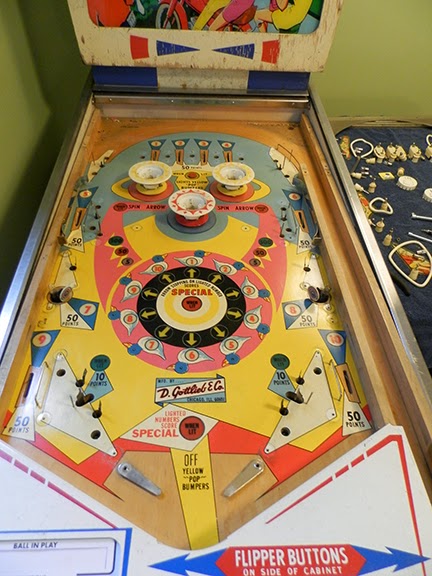The main feature of Fun Land is the spinners, which do a lot of different things. They're the main gateway to the top of the playfield, making them an important target during the game. Activating the spinners also advances the arrows around the dial in the center of the playfield.
If the arrow stops on a lighted number, it scores a free game. This feature works fine. The spinners also score points of their own, alternating between 5, 50 or 500 points (as indicated by lighted inserts). This feature did not work and it didn't take long to figure out why.
This mechanism is the spin relay and Fun Land has two of them. One controls the arrow lights and the other one (the broken one) controls the spinner scoring and score lights. When the spinner spins it moves a leaf switch, which activates a magnet on the relay. The magnet pulls and releases a metal armature with a claw on the end, which turns a plastic gear attached to a pair of contacts on a printed circuit board. Changing the position of the contacts changes which lights are lit and what score is added. It's a very clever piece of engineering.
I looked at the working one and I looked at the broken one and realized that the claw part of the armature had broken off. I was incredibly lucky because the broken bit was sitting on the bottom of the cabinet. I wish I had taken "before" photos.
I first tried super glue but that barely held. Next, I used some stronger stuff - JB Weld adhesive epoxy - and it didn't work much better. Then I had the brilliant idea to splint the broken piece on with some metal wire, so I put down a layer of the epoxy, pressed two short wires over the fissure, and covered them with more epoxy. When it was dry, I did the same thing to the back. There were two problems with this: first, the wires on the bottom were hitting the magnet, preventing the armature from moving completely and it wouldn't push the gear. Second, the wires were too short and the piece broke off again after only a few spins. But I felt I was on the right track, so on the fourth attempt I epoxied one long wire to the top, close to the inside and another long wire on the back near the edge, away from where the magnet hit.

Success! This arrangement has held up ever since and the spinners now work perfectly! I had the wire already and spent about $5 on epoxy - so much better than buying a new armature online for $14.50.







































